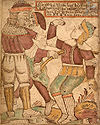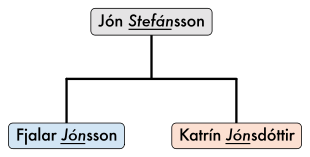- Icelandic name
-
Icelandic names differ from most current Western family name systems by being patronymic (occasionally matronymic) in that they reflect the immediate father (or mother) of the child and not the historic family lineage.
Iceland shares a common cultural heritage with the Scandinavian countries of Norway, Sweden and Denmark with its crown dependency the Faroe Islands. Icelanders, however, unlike other Scandinavians, have continued to use their traditional name system, which was formerly used in all of Scandinavia; it has also been re-introduced in the Faroe Islands. A well-known example is Leif Ericson, son of Erik the Red. The Icelandic system does not use family names. A person's surname indicates the first name of the person's father (patronymic) or in some cases mother (matronymic).
Some family names exist in Iceland, mostly inherited from parents of foreign origin, while some are adopted. Examples of notable Icelanders who have an inherited family name are former prime minister Geir Haarde, football star Eiður Smári Guðjohnsen, Icelandic actress Kristbjörg Kjelld, actor Magnús Scheving, film director Baltasar Kormákur Samper, actress Anita Briem and news reporter Elín Hirst. Before 1925, it was legal to adopt new family names; one Icelander to do so was the Nobel Prize-winning author Halldór Laxness. Since 1925, one cannot adopt a family name unless one explicitly has a legal right to do so through inheritance.[1]
First names that have not been previously used in Iceland must be approved by the Icelandic Naming Committee (Icelandic: Mannanafnanefnd) before being used.[2] The criterion for acceptance of names is whether or not they can be easily incorporated into the Icelandic language. First, they must contain only letters found in the Icelandic alphabet and second, they must be able to be declined (that is, modified according to their grammatical case).
Contents
Typical Icelandic naming
For example, a man named Jón Stefánsson has a son named Fjalar. Fjalar's last name will not be Stefánsson like his father's; it will become Jónsson, literally indicating that Fjalar is the son of Jón (Jóns + son).
The same practice is used for daughters. Jón Stefánsson's daughter Katrín would not have the last name Stefánsson; she would have the name Jónsdóttir. Again, the name literally meaning "Jón's daughter" (Jóns + dóttir).
In some cases, an individual's surname is derived from a parent's middle name instead of the first name. For example, if Jón is the son of Hjálmar Arnar Vilhjálmsson he may either be named Jón Hjálmarsson (Jón, son of Hjálmar) or Jón Arnarsson (Jón, son of Arnar). The reason for this may be that the parent prefers to be called by the middle name instead of the first name; this is fairly common. It may also be that the parent's middle name seems to fit the child's first name better.
In cases where two people in the same social circle bear the same first name and the same father's name, they may be socially distinguished by their paternal grandfather's name, e.g. Jón Þórsson Bjarnarsonar (Jón, son of Þór, son of Bjarni) and Jón Þórsson Hallssonar (Jón, son of Þór, son of Hallur). Although this method is uncommon (as middle names are normally used), such tracing of lineages can easily be seen in the Sagas.
Matronymic naming as a choice
The vast majority of Icelandic surnames carry the name of the father, but occasionally the mother's name is used: e.g., in cases where the child or mother wishes to end social ties with the biological father. Some women use it as a social statement while others simply choose it as a matter of style. An Icelander whose father's identity is uncertain may also carry a matronymic name.
In all of these cases, the convention is the same: Fjalar, the son of Bryndís, will have the full name of Fjalar Bryndísarson ("the son of Bryndís"). One well-known Icelander with a matronymic name is football player Heiðar Helguson, another is novelist Guðrún Eva Mínervudóttir. One medieval example is the poet Eilífr Goðrúnarson.
Some people have both a matronymic and a patronymic: for example, Dagur Bergþóruson Eggertsson, a former mayor of Reykjavík.
Cultural ramifications – how to address people
In Iceland, directories such as the telephone directory are alphabetised by first name rather than surname. To reduce ambiguity, the telephone directory goes further by also listing professions. In Russia, where name-patronyms of similar style were historically used (such as Ivan Petrovich), the much larger population necessitated the introduction of surnames, and delegated the patronymic to record-keeping middle-name and conversational honorific.
Icelanders formally address others by their first names. By way of example, the prime minister Jóhanna Sigurðardóttir would not be addressed as 'Ms' Sigurðardóttir but either by her first name or her full name.
If there are two men named Jón in the same group, perhaps one named Jón Stefánsson and the other Jón Þorláksson, one could address Jón Stefánsson as "Jón Stefáns" and Jón Þorláksson as "Jón Þorláks". When someone holds a conversation with these two people at the same time, the appendage "son" would not need to be used; in that case, the father's name could be used like a nickname, although this is not a common occurrence because many people are in this case instead referred to by their middle names.
Icelandic singer and actress Björk does not use a stage name but simply her first name (her full name is Björk Guðmundsdóttir). Björk is how any Icelander would address her, whether formally or casually. If an interviewer prefers to stick to the English way of addressing Björk, "Ms Björk" would be used.
As a result of each person using patronymics, a family will normally have a variety of last names: the parents could be named Jón Stefánsson and Bryndís Atladóttir, and their children might be Fjalar Jónsson and Katrín Jónsdóttir. With matronymics, the children in this example would be Fjalar Bryndísarson and Katrín Bryndísardóttir.
The Icelandic naming system occasionally causes problems for families travelling abroad, especially with young children, since non-Icelandic customs staff (apart from those of other Nordic countries) are usually unfamiliar with the practice and therefore expect children to have the surnames of their parents.
However, people of Icelandic descent who live in foreign countries, such as the significant Icelandic community in Manitoba, Canada, often do not follow the traditional Icelandic naming system. Instead, they generally adapt to the naming conventions of their country of residence—most commonly by retaining the patronymic of their first ancestor to immigrate to the new country as a permanent family surname.[3]
See also
- List of Icelanders
- Icelandic language
- Scandinavian family name etymology
- Germanic name
- Naming conventions share similarities with Icelandic names: Ethiopian name, Mongolian name, Russian patronymics, Scottish Gaelic personal naming system
References
- ^ Lög um mannanöfn,
- ^ Naming Committee accepts Asía, rejects Magnus, Iceland Review Online, accessed 2006-09-12
- ^ "Icelandic anchor makes Manitoba connection". Winnipeg Free Press, July 26, 2008.
External links
 Icelandic language
Icelandic languageFeatures 
Names History and literature Promotion and purism Árni Magnússon Institute for Icelandic Studies · Icelandic Language Day · Icelandic Language Council · Icelandic Language Fund · Icelandic Language Institute · Icelandic Naming Committee · Linguistic purism (High Icelandic)Related topics Personal names in world cultures Akan • Arabic • Bangladeshi • Belarussian • Bulgarian • Burmese • Cambodian • Canadian • Catalan • Chinese • Croatian • Czech • Dutch • English • Fijian • Finnish • French • Galician • German • Ghanaian • Greek • Habesha • Hawaiian • Hebrew • Hungarian • Icelandic • Igbo • Indian • Indonesian (Balinese • Javanese) • Irish • Italian • Japanese (Amami • Okinawan) • Jewish • Korean • Lao • Latvian • Lithuanian • Malaysian • Mongol • Pakistani • Pashtun • Persian • Philippine • Polish • Portuguese • Roman • Russian • Sakha • Scottish Gaelic • Serbian • Sindhi • Slovak • Spanish (Hispanic America) • Swedish • Taiwanese aborigines • Tatar • Thai • Tibetan • Turkish • Ukrainian • Vietnamese • Yoruba
Categories:- Icelandic culture
- Names by culture
- Icelandic-language surnames
Wikimedia Foundation. 2010.

